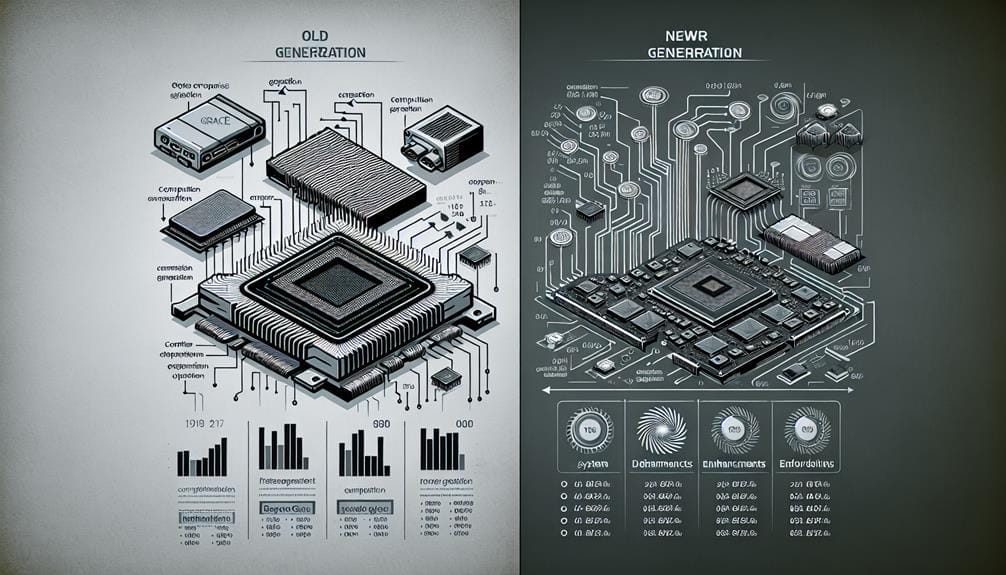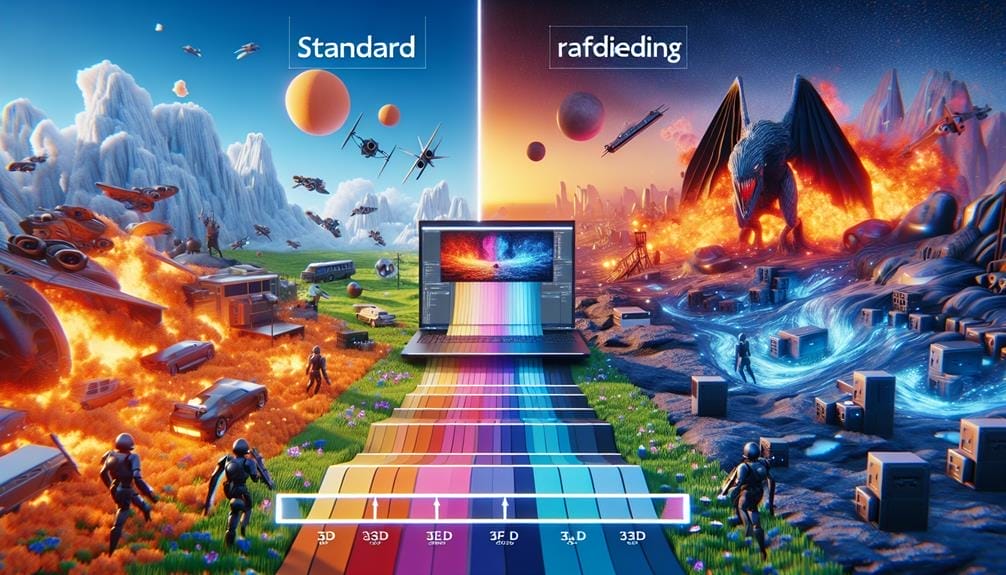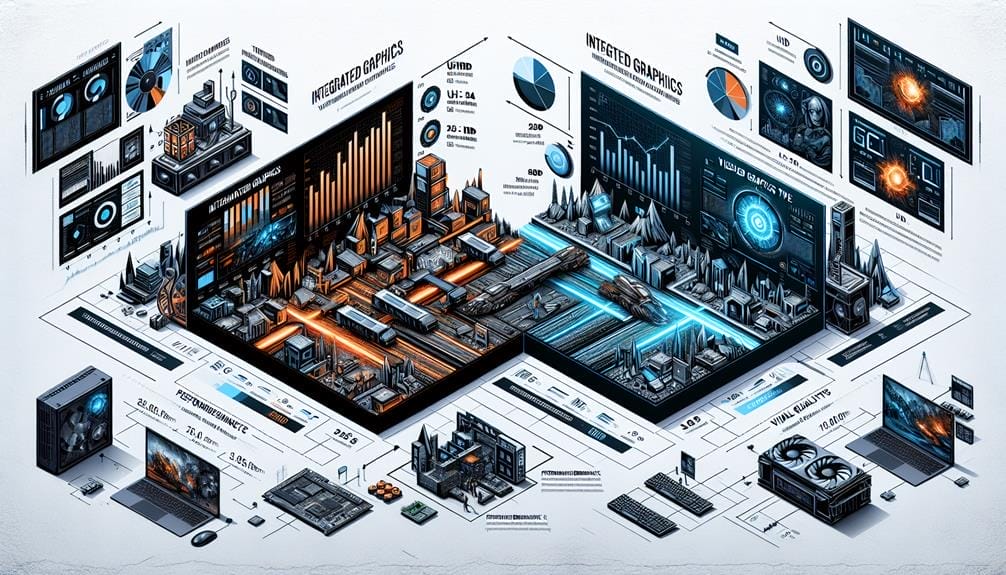Intel's Graphics Showdown: UHD Vs Iris Xe

Recently, there’s been a lot of chatter about Intel’s UHD and Iris Xe graphics, igniting a fiery debate over which of the two truly surpasses the other in power and capabilities.
As users increasingly rely on integrated graphics for a variety of tasks, the distinctions between these two offerings have garnered attention for their potential impact on user experience and computing capabilities.
Understanding the intricacies of these graphics solutions is crucial for individuals seeking to optimize their computing setups, but the question remains: which of these Intel offerings ultimately prevails in the realm of integrated graphics?
Key Takeaways
- Integrated graphics serve multiple functions and offer troubleshooting support.
- Intel Iris Xe Graphics is the best and most capable integrated graphics from Intel, suitable for playing older games and video editing.
- Intel UHD Graphics is widely used and sufficient for general productivity tasks.
- AMD's latest iGPUs outperform Intel in terms of sheer horsepower and are comparable to mobile GTX 1650 in gaming performance.
Evolution of Integrated Graphics

The evolution of integrated graphics has been a pivotal aspect in the advancement of computing technology, significantly impacting the capabilities and performance of modern processors.
Over the years, integrated graphics technology has undergone substantial advancements, particularly in the realm of gaming. Intel's UHD Graphics, introduced in 2010, marked a significant step forward, catering to non-demanding users, content creators, and gamers. It could handle light gaming and various resolutions.
The subsequent development of Intel Iris Xe Graphics, found exclusively on mobile processors, further elevated integrated graphics capabilities. With higher operating frequency, more execution units, and higher memory bandwidth, Iris Xe is more suitable for gaming, albeit not designed for demanding AAA titles.
This evolution has demonstrated the increasing impact of integrated graphics on gaming, providing viable options for a broader range of gaming experiences.
Intel UHD Graphics Overview
Having explored the evolution of integrated graphics and its impact on modern processors, the focus now shifts to providing an in-depth technical analysis of the Intel UHD Graphics.
The evolution of UHD graphics since its introduction in 2010 has resulted in widespread adoption due to its suitability for non-demanding users, content creators, and gamers.
One of the key benefits of UHD graphics is its ability to drive multiple 4K displays while offering Quick Sync technology for enhanced timeline and rendering performance.
Additionally, its lower power consumption allows for thinner designs, making it an ideal choice for thin and lightweight laptops.
These features make UHD graphics sufficient for general productivity tasks and capable of handling various codecs and resolutions, making it a practical choice for a wide range of users.
Intel Iris Xe Graphics Overview

In the realm of integrated graphics, Intel's Iris Xe Graphics emerges as a formidable contender, offering advanced capabilities and tailored performance for specific user requirements. It is the best and most capable integrated graphics from Intel, found exclusively on mobile processors. Iris Xe Graphics boasts a higher operating frequency, more execution units, and higher memory bandwidth compared to Intel UHD Graphics. This makes it suitable for playing older and undemanding games, and an excellent option for video editors with Quick Sync technology. However, it won't provide significant everyday performance uplift, and it's not designed for AAA titles. The following table provides a concise comparison of the advantages and limitations of Intel Iris Xe Graphics:
| Advantages | Limitations |
|---|---|
| Higher operating frequency | Won't provide significant everyday performance uplift |
| More execution units | Not designed for AAA titles |
| Higher memory bandwidth |
Performance Comparison: UHD Vs Iris Xe
Based on an in-depth analysis of their performance attributes, the comparison between Intel UHD and Iris Xe Graphics reveals distinctive capabilities and limitations essential for understanding their respective suitability for varied computing tasks.
- Performance Comparison
- UHD Graphics: Suitable for general productivity tasks and light gaming.
- Iris Xe Graphics: More advanced, better for gaming, and capable of playing older and undemanding games.
- Both offer benefits and fulfill their intended roles.
- Gaming Capabilities
- UHD Graphics: Capable of light gaming and handling various codecs and resolutions.
- Iris Xe Graphics: Better for gaming but not designed for AAA titles.
- Overall Assessment
- UHD Graphics are sufficient for non-demanding users, content creators, and gamers.
- Iris Xe Graphics provide a more advanced option, especially for gaming and video editing tasks.
Intel Vs AMD Integrated Graphics

Intel and AMD's integrated graphics solutions are pivotal components in the realm of computing, each offering distinct capabilities and performance characteristics. Here is a comparison of gaming performance between Intel and AMD integrated graphics:
| Aspect | Intel Integrated Graphics | AMD Integrated Graphics |
|---|---|---|
| Gaming Performance | Suitable for light gaming and handling various codecs and resolutions | Outperforms Intel in sheer gaming horsepower |
| AAA Gaming | Not designed for AAA titles | Comparable to mobile GTX 1650 in gaming performance |
| Efficiency and Performance | Quick Sync technology enhances timeline and rendering performance | Gains tied to manufacturing process and design, efficient |
Intel's Quick Sync technology makes it advantageous for video editing, while AMD's latest iGPUs outperform Intel in sheer gaming horsepower, comparable to a mobile GTX 1650. Other gains in efficiency and performance are tied to the manufacturing process and design.
Future of Intel's Graphics Technology
The evolution of Intel's graphics technology promises to redefine the landscape of integrated graphics solutions for future computing platforms. Looking ahead, Intel's advancements in graphics technology are set to have a profound impact on the gaming industry. Here's what we can expect:
- Increased Performance: Future advancements in Intel's graphics technology are likely to bring significant improvements in performance, enhancing the gaming experience for users.
- Enhanced Visuals: Intel's focus on advancing graphics technology is anticipated to lead to improved visual quality, including better rendering, textures, and overall graphical fidelity in games.
- Competitive Edge: Intel's forthcoming graphics technology is poised to challenge established players in the dedicated GPU market, potentially reshaping the competitive dynamics in the gaming industry.
These developments highlight the pivotal role that Intel's graphics technology could play in shaping the future of gaming and computing.
Conclusion
In conclusion, the comparison between Intel's UHD and Iris Xe graphics reveals distinct features and performance differentials that impact user experience.
The evolution of integrated graphics, performance comparison, and the future of Intel's graphics technology are critical considerations for users seeking optimal functionality.
Understanding the nuances of these graphics solutions is essential for making informed decisions regarding computing needs.
Overall, the comprehensive analysis provides valuable insights into the attributes and suitability of Intel's integrated graphics solutions.

